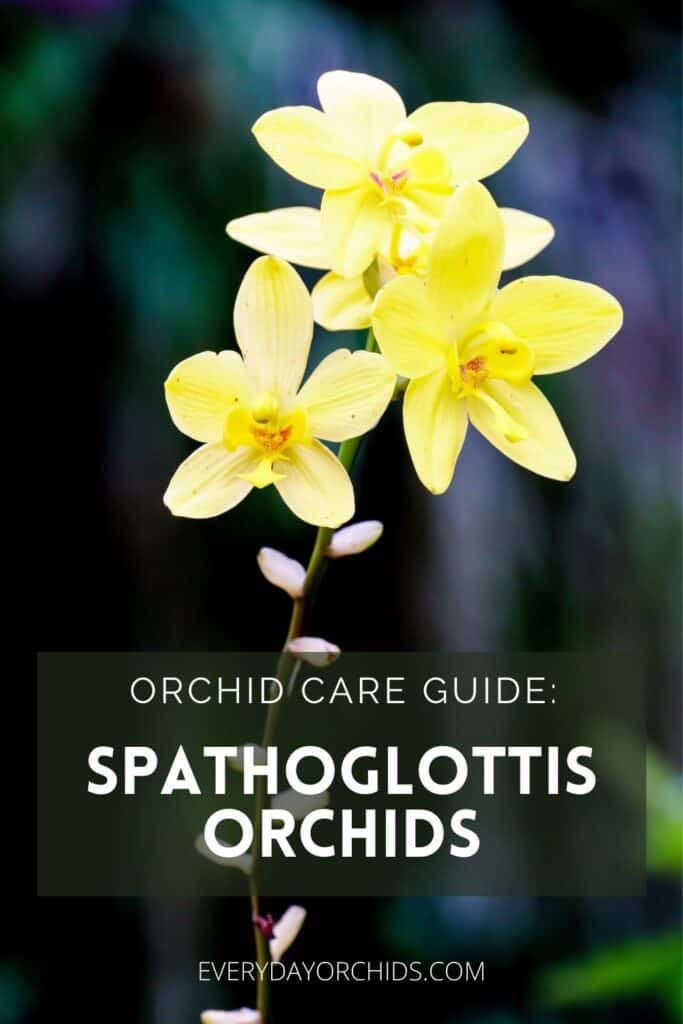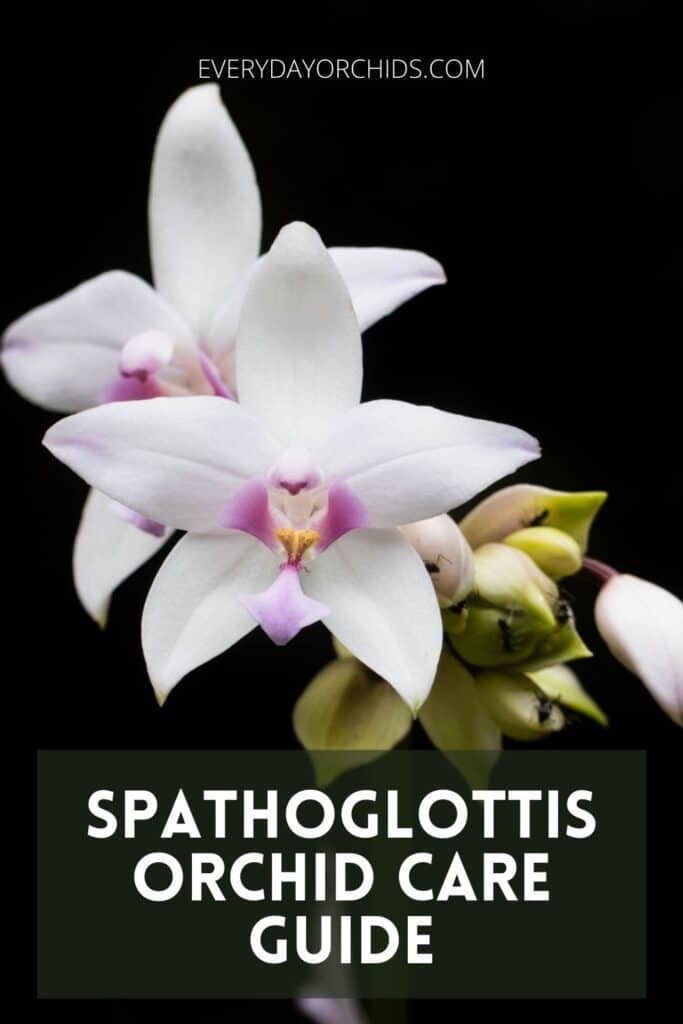If you are looking for a good starter outdoor orchid, look no further than Spathoglottis orchids. These orchids are fairly easy to grow. They are a good place to start if you are looking to dip your feet into growing terrestrial orchids.
Spathoglottis orchids require lots of bright, indirect light and can even tolerate several hours of direct sunlight each day. They need frequent watering during the growth period. Regular fertilization with a high nitrogen orchid-specific fertilizer is a must. These orchids thrive in warm, humid environments and prefer humidity levels around 60 to 70%.
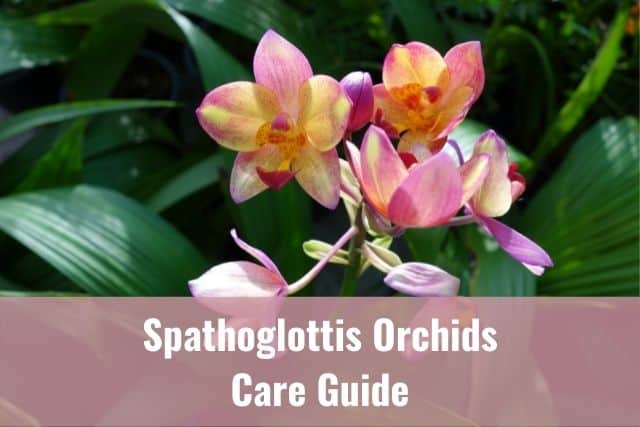
If you are new to Spathoglottis orchid care, don’t worry. These orchids are easy to care for and great for beginners. I’ll give you a basic overview of Spathoglottis orchids and what they need in terms of care. Keep reading to learn about the growing requirements of Spathoglottis orchids.
Please note that these links are affiliate links and as an Amazon Associate, I earn from qualifying purchases. Purchases made through affiliate links in this post may generate commissions at no additional cost to you. Use this link for a discounted Amazon Prime trial. Thank you for your support!
Table of Contents
All About Spathoglottis Orchids
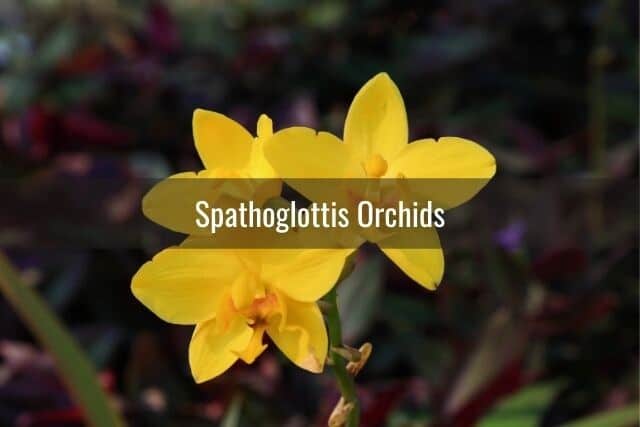
Spathoglottis orchids are popular ground orchids. They are quite versatile and can be grown in pots or in garden beds. Within this group of orchids, there are over 40 different varieties, including the popular Spathoglottis plicata, AKA the “ground orchid,” Spathoglottis pubescens, AKA “shining star,” and the Spathoglottis cabaret.
Spathoglottis orchids can be found throughout the world, primarily in Asia, Australia and the Pacific Islands. These orchids are popular landscaping orchids and add a pop of color to gardens. They especially tend to look great in gardens with tropical landscapes or along the borders of garden beds.
In fact, raised garden beds are an ideal planting location for these orchids. There is plenty of drainage and using a raised garden bed allows you to control the type and quality of soil used.
After planting these orchids, allow up to 6 months for the orchid to adjust to the new environment and for the pseudobulbs to mature a little. Once this time has passed, the orchid will start bloom production.
These orchids produce tall flower spikes and have large, showy blooms. These blooms come in a variety of colors ranging from white, pink, purple, or yellow and can bloom throughout the year. The orchid blooms may also attract butterflies.
Spathoglottis orchids grow to be about 18 to 24 inches tall. The wide leaves are a bright, grassy green color and emerge from pseudobulbs at the base of the orchid.
Temperature Tolerance
These are tropical orchids and do best in warm, humid environments. If you live in a climate that is warm year-round, such as Florida, Hawaii or southern California, you can plant these outdoors and leave them in the ground. If you live in Asia, or any of the locations this orchid is native to, you can also leave these terrestrial orchids outdoors year-round.
However, if you do not live in a climate that is warm year-round, be aware that these warm-weather loving orchids cannot tolerate frost or very cold temperatures.
Their temperature tolerance ranges from 60 degrees Fahrenheit at night to 90 degrees Fahrenheit during the day. If you live in a climate that experiences temperature drops in the fall and winter, plant your Spathoglottis orchid in a pot. Then, as temperatures start to drop in the fall, start transitioning these orchids indoors as part of your fall orchid care.
Lighting Requirements
These orchids do well in a range of lighting conditions and can tolerate anything from partial shade to full sunlight.
When selecting a planting location for your Spathoglottis orchid, try to plant them in a location where they will be exposed to direct sunlight for at least a few hours each day. If not, then at minimum, make sure that they will still get plenty of bright, indirect sunlight throughout the day.
These are considered to be high light orchids. Remember, lots of light is key to helping your orchids bloom.
Watering Your Spathoglottis Orchid
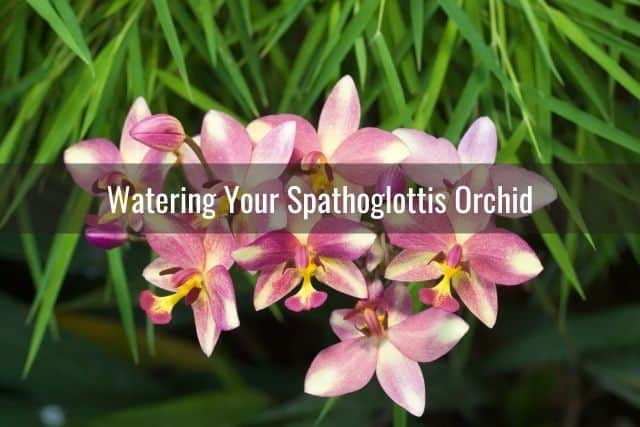
Knowing how to water your orchids can be tricky, but here are some key points to remember when caring for your Spathoglottis orchid.
Water when you notice that the top-most layer of soil is dry. During growing season in the spring, you will likely need to water these orchids more frequently, so pay close attention to the top layer of the potting media. Spathoglottis orchids prefer the potting media to remain evenly moist and not dry out completely.
On the flip side, be careful not to overwater your orchid. Don’t let your orchid pot sit in water. Also, if the top layer of potting media is still damp or wet, wait another day or two and check again before watering your orchid
Terrestrial orchids, just like any other orchid, can be affected by root rot, mold, and other issues if the orchid is watered too frequently. Root rot can also happen if the soil has inadequate drainage and the roots remain constantly moist.
In addition, try to water your orchids early in the morning. This will reduce the risk of mold, fungal infections and rot from occurring.
Humidity Needs For Spathoglottis Orchids
As these are tropical orchids, you might guess that they prefer high humidity, and you’d be correct. Keep humidity levels around 60 to 70% for these orchids. You can monitor outdoor humidity levels using a hygrometer, placed near your orchid’s growing area.
Make sure the orchids have good air movement between the leaves and flower stalks. This will go a long way in preventing mold and fungal growth. Also, regularly prune your orchids and remove dead leaves and growth. This is important to prevent disease and pest infestations.
Fertilization Tips
These orchids also require regular fertilization with a high nitrogen fertilizer, especially during the growing season.
Aim to fertilize your Spathoglottis orchid each week during the growing season in the spring and summer. Use a diluted orchid-specific fertilizer to feed your orchids. As growth slows down in the fall and winter, you can decrease fertilization to twice a month, or every other week.
Alternatively, you can use a slow-release orchid fertilizer to feed your Spathoglottis orchids.
If you are having trouble getting your orchid to bloom, you may want to look into an orchid fertilizer with a higher phosphorus level, such as a bloom booster orchid fertilizer.
You can read more about how to fertilize your orchid here.
Potting And Repotting Your Spathoglottis Orchid
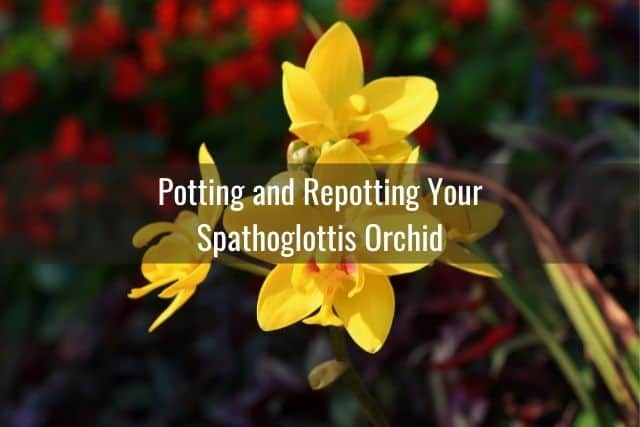
Repotting your Spathoglottis orchid is unnecessary if you are growing this as a terrestrial orchid in your garden bed. If your orchid is primarily grown outdoors, the only time you may want to dig up your orchid is to divide it and manage excessive growth.
When planting your Spathoglottis orchid in your garden, space individual plants at least 12 to 18 inches apart. This will give the orchid some room to grow and spread out. Keep the pseudobulbs above ground and avoid burying them in the soil.
If you grow your Spathoglottis orchids in pots, you will need to repot this orchid every 2 to 3 years. Make sure you use well-draining orchid potting media. This may include some rich, organic material, bark, perlite and peat.
If you are unsure of what potting media to buy, look for something similar to what you’d use for Cymbidium orchids. You can also buy orchid potting mix specific to terrestrial orchids online. Be very careful when removing your Spathoglottis orchids from the pots, as their root system can be easily damaged.
Propagation
These terrestrial orchids spread out laterally and can be propagated by pseudobulb division. Wait until you have at least 6 pseudobulbs, or clumps, before you do this. Once the orchid is separated into groups of 3 pseudobulbs each, you can pot each group into a pot or into the ground.
For a step-by-step guide, read about how to propagate orchids via pseudobulb division here.
Pests And Diseases
Spathoglottis orchids can fall prey to a variety of orchid pests such as spider mites and mealybugs. Do regular inspections of your orchid plants so you can spot orchid pests early. If you see evidence of spider mites or mealybugs or any other pests, early and immediate treatment is necessary. For more information, read these guides on how to get rid of spider mites and remove mealybugs from your orchids.
These orchids are also prone to diseases such as fungal infections and rot. You can prevent fungal infections and rot from occurring by maintaining good airflow between plants and avoid overwatering your orchids. Make sure that older yellowed or browned leaves are pruned away promptly.
Final Thoughts
Spathoglottis orchids can add a unique touch to your garden and bring variety to your orchid collection. They aren’t difficult to care for, as you can see from the growing requirements above.
If you live in a climate that is warm and humid year-round, such as Florida, Hawaii, or Asia, look into adding Spathoglottis orchids to your garden. Even if you don’t live in a warm, humid environment, these terrestrial orchids can be grown in pots and brought indoors when temperatures start to fall.
As always, happy orchid growing!
If you enjoyed this article, please pin it and share!
